
By: Judit Monis, Ph.D. – Vineyard and Plant Health Consultant
Grapevine trunk diseases occur worldwide and are caused by bacterial, fungal pathogens, or a combination of both. Important trunk disease fungal pathogens are airborne and not only affect grapevines. Many, also cause disease in landscape and fruit trees and can be found colonizing the orchard or vineyard soil. Grapevine stock can be infected with important pathogens which makes it important to screen nursery material for their presence prior to planting.
In a recent article, I covered the bacterial trunk disease caused by Agrobacterium vitis. This article will focus on grapevine trunk diseases caused fungal pathogens. As with viruses and bacteria, fungal pathogens can be found in mixed infections exacerbating the problem in a vineyard.
Petri Disease, Young Vine Decline, Esca: The disease in young vines, known as young vine decline, is caused by Cadophora, Phaeoacremonium, and Phaeomoniella species. In older vines, the same fungal pathogens are associated with Esca disease. The disease is chronic when vines express a gradual decline of symptoms over time, or acute when the vines decline and die within a few days. These acute symptoms are known as the apoplectic stage of the disease. It is not uncommon during the apoplectic stage of the disease to see dead vines carrying mummified grape bunches.
Canker Diseases: Various pathogens can cause canker symptoms, large discolored areas in trunk and canes (Photo #1), in the vineyard. Bot-canker or dead arm disease is caused by different species in the Botryosphaeriaceae family. The most severe Bot-canker species is Lasidiplodia theobromae, while weaker symptoms are caused by Diplodia species. Eutypa dieback is caused by different species in the Diatrypaceae family. The best characterized and known species is Eutypa lata, but species of Criptovalsa, Diatrypella, and Eutypella can also cause canker disease in grapevines. In my lab we characterized Seimatosporium species as a fungal pathogen that causes decline and cankers in grapevines, but within the same fungal group others have reported Pestalotoipsis and Truncatella to cause disease in grapevines. Another canker pathogen includes Diaporthe (also known as Phomopsis). The canker symptoms observed in the sections of affected cordons or trunks in grapevines may appear to be similar but caused by unrelated fungal species, however, the life cycles and mode of infection may be different.
Black Foot Disease: Species of Campylocarpon, Cylindrocladiella, Dactylonectria, and Ilyonectria (previously known as Cylindrocarpon spp.) are the causal agents of this complex disease. These fungi are soil-born and most active on compact soils with poor drainage. Symptoms above ground can be indistinguishable from young vine/ Esca disease described above. Additionally, the decline symptoms can be confused with Pierce’s disease, caused by Xylella fastidiosa, a bacterial pathogen.
Sudden Vine Collapse Syndrome (previously known as Grapevine Mystery Disease): Some years ago, Lodi growers in California reported a syndrome in which their vines collapse and die within a short period of time. In 2011, while working at STA, we tested vines with similar symptoms, not just from Lodi, but from California’s Central Valley, and Central Coast vineyards (see photo #2). We detected a combination of fungal pathogens (not always the same usual suspects) and viruses, namely Grapevine leafroll associated -3 (GLRaV-3) and Grapevine virus A and F (Vitiviruses).
Researchers at the University of California at Davis with fungal expertise (Dr. Akif Eskalen) and viral expertise (Dr. Maher Al Rwahnih) have continued to work on vines expressing the sudden vine collapse syndrome. Samples from symptomatic vines were subjected to high throughput sequencing to look for viruses in Al Rwahnih’s laboratory. Concurrently, fungal culture work was performed in the Eskalen laboratory. Interestingly, the results were similar to those found in my laboratory: various fungal pathogens (not consistent in every sample), GLRaV-3, and Vitiviruses were detected in the collapsed vines. This year, these researchers concluded (Eskalen’s presentation at the 12th International Workshop on Grapevine Trunk Diseases) that the syndrome is not caused by one single organism but a combination of viral and fungal pathogens.
Other diseases: Species of Armillaria mellea (Oak root fungus), Phytophthora, and Verticillium are soil-born fungal species capable of causing decline and rots in the vineyard. Just as described above for black foot disease, these pathogens strive in compact soils with poor drainage.
Disease Prevention and Management: The best disease management and control measure recommended is to prevent the introduction of pathogens in the vineyard. None of the US-certification programs exclude trunk disease pathogens. Therefore, propagation material is most likely infected with various fungal pathogens.
The implementation of appropriate sanitation measures at the nursery is most needed to produce high quality planting grapevine material. It is known that one infected vine can produce between 100 -200 vines each year, potentially producing a significant number of infected grafted plants. The use of hot water treatment (HWT) for 30 minutes at 50C (122F) at the nursery has shown a reduction of fungal pathogens in propagated vines. However, there are mix reports on the effect of the HWT on bud mortality. Reports in warmer winegrowing regions (e.g., Spain) have shown a lower effect on bud mortality compared to HWT in cool climate regions (e.g., Australia). Because fungal pathogens cannot be eliminated in the vineyard once introduced, it is important to learn and apply the best management practices available.
When planting a new vineyard, it is important to inspect the quality of the planting material (graft union integrity, lack of galling, absence of streaking or pitting). High quality planting material must be planted in well prepared and drained soil, at the correct season. The best practices in the vineyard must be applied (i.e., enough water, nutrients, etc.). Many of the fungal pathogens that cause disease in grapevines are endophytic, meaning that these can live in the vine without causing disease. However, these same fungi can become pathogenic during stress situations (lack of water, heat wave, etc.).
It is known that the effect of grapevine fungal pathogens increases as the vineyard ages (the fungal population continues to multiply seasonally). Therefore, growers must adopt management and control measurements as soon as the vines are planted in order to prevent and minimize the propagation and dispersal of fungal pathogens.
Management at the vineyard should include expertly trained personnel for pruning activities. In California where the rainy season coincides with the pruning season it is recommended to prune as late as possible in the spring prior to bud break. Since the vine is active in the spring, the wound healing will occur faster. Another reason for late pruning is that most fungal trunk disease pathogens release spores during the rainy season. Therefore, in areas with predominantly winter precipitations, the proportion of spores available to start an infection would have been reduced to a minimum. If the vineyard is large, the double pruning method is recommended. This consists of the mechanical pre-pruning of vines in the start of dormancy, leaving canes of 1-2 feet long. In the spring or late winter, the pruning is completed by leaving the desired final number of buds per spur. The freshly produced wounds should be protected using fungicides or a sealant such as VitiSeal. During pruning it is important to avoid producing large wounds, cutting near the trunk, pruning after long periods of rain, and leaving vine residues in the vineyard floor.
Economic studies performed by Dr. Kendra Baumgartner and colleagues (USDA in UC Davis, California) has shown that preventative methods (late pruning, double pruning, and pruning wound protectants) are sustainable only if applied before symptoms appear in the vineyard. Adopting these methods in vines that are 10 years old or older will not recover the cost of investment.
A more drastic disease management practice includes vine re-training also known as remedial surgery. The procedure consists of training a new shoot from the base of the trunk to replace the old decayed vine trunk or cordons. The technique can help gain some years of production but will not cure the vines from the disease as likely the pathogens are systemically established in the vine. Keep in mind that the pathogenic fungi are systemic in the vine, and as mentioned earlier this method can buy some time before the vine declines and dies. When replacing vines, the grower must understand that fungal pathogens are able to survive in dead portions of the roots, therefore new vines that are planted (even if free of bacterial or fungal pathogens) can become infected over time if vine roots are not completely removed from the vineyard.
Other methods that have been reported for the management of fungal diseases include planting mustard (Sinapsis alba) plants as cover crops that act as a biofumigant and biological control agents such as Trichoderma species, and mycorrhizal fungi. This year, at the 12th International Workshop on Grapevine Trunk Diseases, Josep Armengol and collaborators (Universidad Politecnica de Valencia) reported a decrease in spore dispersal in grass and cover crop plots relative to the bare soil plots.
New and more sensitive pathogen detection methods that apply next generation sequencing (also known as high throughput sequencing) are now available commercially for the detection at the species level of microorganisms in plants and soil. It is expected that the application of early and efficient diagnoses will help reduce the infection levels of planting material and consequently avoid disease onset in the vineyards.
Judit Monis, Ph.D. is a California-based plant health consultant, provides specialized services to help growers, vineyard managers, and nursery personnel avoid the propagation and transmission of disease caused by bacteria, fungi, and viruses in their vineyard blocks. Judit is fluent in Spanish and is available to consult in other important wine grape growing regions of the word. Please visit juditmonis.com for information or contact juditmonis@yahoo.com to request a consulting session.






